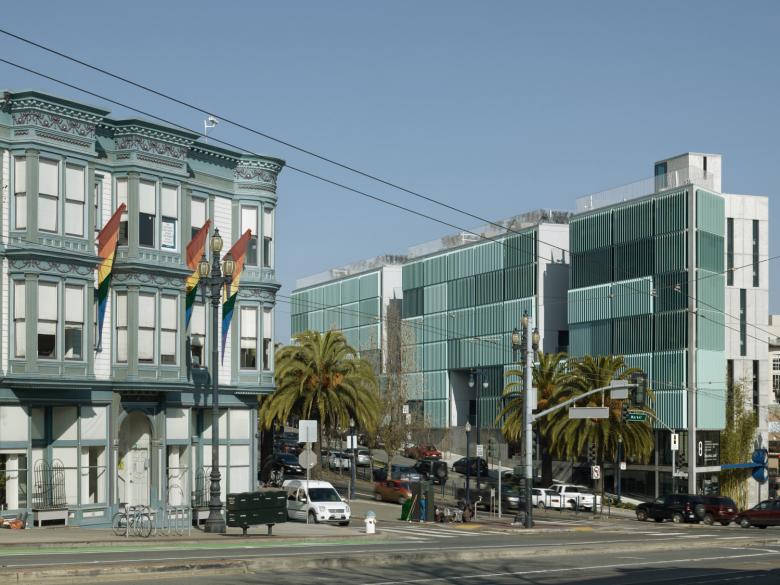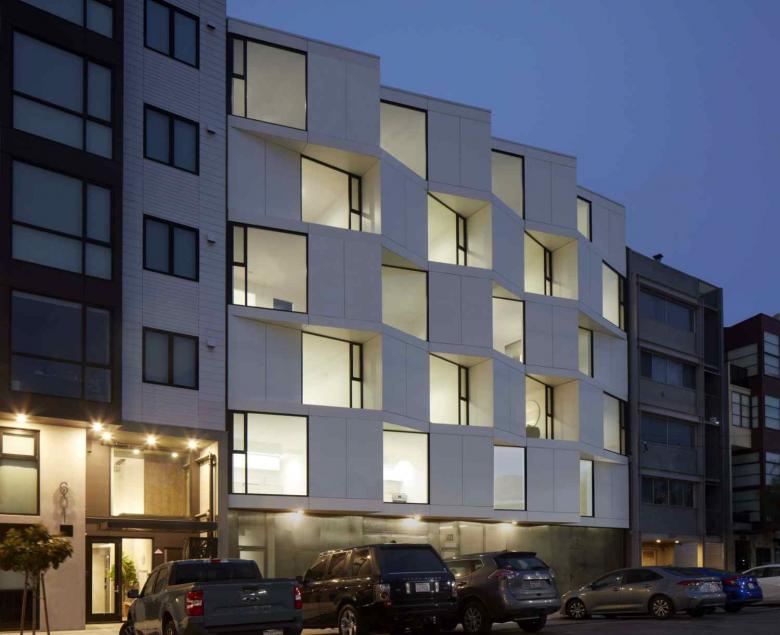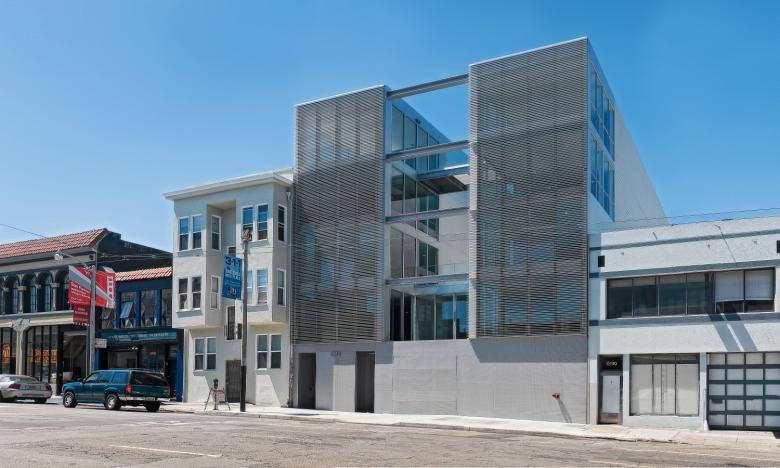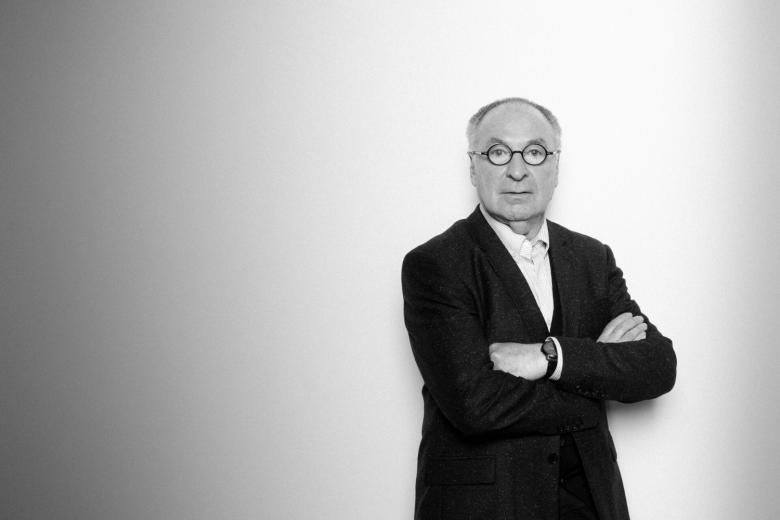10. October 2023
8 Octavia, San Francisco (Photo courtesy of Stanley Saitowitz | Natoma Architects Inc.)
In this interview with Vladimir Belogolovsky, Stanley Saitowitz discusses coming to America from his native South Africa, studying at Berkeley, getting excited when his architecture succeeds in finding its own logic and starts to form itself, working with the earth and grid, the differences between San Francisco and Los Angeles, and fighting conservatism in his adopted hometown.
While preparing for my conversation with San Francisco architect Stanley Saitowitz, I learned that at least some of his unambiguously progressive buildings are dubbed “refrigerators” and “washing machines” by locals reacting to their striking high-tech characteristics. When I shared with him this insight, the architect was not surprised in the least: “My approach to building in a very diverse urban fabric is to try to synthesize different architectures by using industrial materials with texture and a level of elaboration that evokes the complexity of historical architecture. For example, steel trusses become exposed as an ornament. These buildings synthesize a variety of aesthetics. But for people without sensitivity to design, anything that’s different is demeaned.”
Saitowitz was born in Johannesburg in 1949, growing up in the city’s suburbs in the midst of a construction boom. As a child he saw buildings emerge one by one all around his family’s house. “Seeing buildings grow from nothing was magical,” he told me, “I still remember the smell of bricks and mortar and wood being cut. And I would sneak into the houses after the contractors left to imagine how those spaces would be, once completed.” His interest in buildings was explicit, as he recalled in a curious memory: “Whenever I came back from birthday parties, rather than talk about the cake I would describe the house.”
Saitowitz went on to study architecture in his hometown at the University of the Witwatersrand from which he obtained his bachelor’s degree in 1974. There was a tradition at Wits for students to go to the United States for graduate school. Imagining California as a romantic place on the West Coast, he opted for the University of California at Berkeley, where he studied with Christopher Alexander and Horst Rittel, among others. After graduation Saitowitz was asked to teach as an assistant professor at UC Berkeley, which led to him staying in the US. He started his practice, Natoma Architects, named after the studio’s street address, on the occasion of a commission to design an auditorium at the university’s Wurster Hall. Even though the architect no longer teaches, he continues to attend student reviews and he gives occasional lectures.
1028 Natoma, San Francisco (Photo courtesy of Stanley Saitowitz | Natoma Architects Inc.)
Vladimir Belogolovsky (VB): Describing your work, you use such words and phrases as simplicity, synthesis, geological architecture, geological forces, biomorphic, geometric, cosmological sources, earth-centric and cosmos-centric, cave-like, enveloping, and a tool of liberation. How else would you describe your work and the kind of architecture that you try to achieve?Stanley Saitowitz (SS): I think of architecture as a way it can contribute to building the city. I see each building as an opportunity to continue and repair a piece of the city. Although I still enjoy working on occasional houses in the landscape, most of our work is in cities. It is mostly here in San Francisco or in Los Angeles. The idea is to reinforce the character of the site in these cities. It has to be contemporary but also connected to the history of the place. It is not about invention; it is about extraction. One of the phrases you mentioned is geological forces. That’s about building a building as a sort of continuation of a geological process that has formed the land. I think building in cities is similar if you understand the city fabric as geography, which is how I see it. The city is a geographic reality that I address as fact and evolve and renew.
SS: My teacher at the University of the Witwatersrand, Pancho Guedes, a remarkable Portuguese-born architect who practiced in Lourenço Marques (modern-day Maputo, the capital of Mozambique), used to tease me that I always start with a grid. And it is probably true. In a way everything, from an urban scale to a piece of furniture, is formulated on a system of the grid. Of course, there are people who are interested in transforming and distorting the grid. But I am more interested in evolving it by finding new layers of surprise and richness. That’s why I keep referring to the idea of a city. I believe that architecture’s true project is about building the city. That’s an overriding goal. It is not about itself but about a greater whole.
603 Tennessee, San Francisco (Photo courtesy of Stanley Saitowitz | Natoma Architects Inc.)
VB: What are your first steps when you start a project?SS: It usually happens in my head when I am sleeping. [Laughs.] There is no one method. Sometimes things just come and other times I struggle. And I usually have a clear idea before I pass on the initial idea to my team. We are a small practice of about 15 people, and some of the architects have been working with me for 30 years. There is a strong connection, but I always start a project by producing sketches and my team picks up from there. And when I am sketching and thinking, suddenly things start to interact and direct themselves, in a way. The work becomes exciting when it starts to form itself. Sometimes you step back and the drawing itself starts telling you what the next step is.
SS: I always thought of buildings as taking the earth and weaving it into the sky. That’s still the process that I start when I think about making a building. It is about working with materials and space and how the two operate with each other. What interests me now is lightness and how to accomplish the most with the least. That’s what Buckminster Fuller asked Norman Foster, “How much does your building weigh?” In other words, there are ecological questions that we have to think about when we build. I would say lightness has become my focus.
1234 Howard Street, San Francisco (Photo courtesy of Stanley Saitowitz | Natoma Architects Inc.)
VB: Here is another one of your quotes: “I treat the city like nature.”SS: Because it is a fact. It is a reality. It has an evolved history and it is a moment in time just like a site in the landscape. At the same time, I am not nostalgic. I believe in the present and the new. Yet, I also believe in connection. I don’t understand buildings that land out of nowhere. I want my buildings to contribute to the continuity of the city. I enjoy cities that have coherent urban fabrics and textures such as Istanbul or Lisbon. There are domes in Istanbul that dominate, and in Lisbon facades carry beautiful tilework. I favor the idea for architects to add to what has become a character of the place. Each is unique. When I work in LA I have a different approach to working in San Francisco.
SS: Well, LA is open and light, and there is a big scale. There is acceptance of modernity. Starting from Rudolph Schindler and the Case Study Houses, there is an embrace of modern architecture. Also, in LA there is more autonomy and less dependency on context. In contrast, in San Francisco the Victorian presence is very strong. That’s a delicate and more feminine quality to buildings — softer and more absorbing. So, in San Francisco I try to identify a unique character on the street and work from there. Again, not in a nostalgic way but to reinvigorate the place. So many buildings in San Francisco are designed as facade collages put together out of various materials without any connection to the interior logic. Actually, it has become a popular design strategy here. Many architects respond to the urban character of the street simply by throwing up a junk pile of materials, which misrepresents the character of the original city streets. These facades don’t even try to express the life within. But I believe a building is a thing, not a wallpaper. That’s what I tried to show in our 8 Octavia, which appears almost breathing and changing with the time of day and seasons. Occupants can modulate the sunlight and sound in their units. Doing that, they also redraw the exterior elevation, displaying their occupancy to the city outside as a sort of animated billboard.
2002 Third Street, San Francisco (Photo courtesy of Stanley Saitowitz | Natoma Architects Inc.)
VB: The fact that your projects are typically titled after their street addresses is another evidence of expressing their locale, right?SS: That is true. But right now I am building a house here near the beach and it is called the House of Fog because that part of the city is unusually foggy.
SS: Let me elaborate on that. In old photos, the urban fabric of San Francisco looks very cohesive, all the pieces contribute to a whole. Then in the 1960s, with the free speech movement, the “painted ladies” emerged where each building tried to upstage its neighbor and be unique. Buildings that had been part of a continuous context became buildings that were independent and individual. That ethos still drives a lot of contemporary work in San Francisco. My interest is in maintaining continuity in the city and preserving the original fabric of the city as much as possible. So, these two contradictory strategies constitute the main struggle for me. My work is always singular in a way, but it is about totality. Many other architects separate their buildings from the city and also tend to fragment them into smaller individual pieces, something I described earlier as a wallpaper collage. But our work is a way to repair places piece by piece, fixing a corner here and filling in a “missing tooth” there. We see our buildings as a way to repair urban fabric. In San Francisco you have to tie pieces together. A building is interesting only if it is more than just itself. Buildings need to improve the context. And I believe it is possible to do a building which is itself but also makes the surrounding buildings better.
Center for Jewish Life, Philadelphia (Photo courtesy of Stanley Saitowitz | Natoma Architects Inc.)
VB: Let me ask you about your relationship with LA. After all, you once remarked, “I think about moving to LA every day.”SS: [Laughs.] Well, I am lucky that I have a lot of work in LA. I like it there because there is an appreciation of architecture and modernity, which is less prevalent in San Francisco. When I work in LA and I go to the planning department we start at a base of agreement that modern architecture is acceptable and reasonable. Whereas here, when I go to the planning department there is always suspicion. They always look at me like, “What is he doing now?!” [Laughs.]
SS: Pretty much. I do have support but overall people are very conservative here. There is little understanding of what architecture has to offer.






